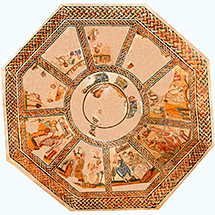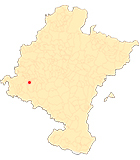The Roman villa of Arellano
Introduction
Immune to the urgencies of time, this peaceful farm from Roman times accumulated centuries of history with the innate serenity of places where the clock seems to have stopped. Its walls have sheltered the everyday and routine, the exceptional and transcendent and the secret and clandestine. Located in the municipality of Arellano, the first news about the place dates back to the end of the 19th century, when an octagonal mosaic dedicated to the Muses was found by chance and transferred to the National Archaeological Museum. Excavated at different points by Blas Taracena in the mid-20th century, the systematic work, under the direction of Mª Ángeles Mezquíriz, began in 1985 and continued uninterruptedly until the year 2000. In 2003, the director of the excavations published an extensive monograph, La villa romana de Arellano, which is fundamental for the knowledge of the site.
The village of Arellano dominates a small valley, bordered to the south and west by the Cortabaco mountain range and to the north by the foothills of Montejurra. The landscape, despite the logical transformations, conserves the essence and appearance that these lands must have had in Roman times. A colourful mosaic where the small hills populated by holm oaks, oaks and pines intertwine with fields devoted to the ancestral crops of the Mediterranean triad: cereals, vines and olives.
The settlement of Italic population groups in Hispania from the 2nd century BC onwards was the starting point of a profound rural revolution. Most of them were war veterans who had been granted land as payment for their services and who brought with them new building techniques, new architectural models and a new system of land use. A model of exploitation known in the Roman world by the name of villa, of which Arellano is a magnificent example.
The images and recreations of the different spaces that accompany this text have been loaned by the Heritage Service of the Directorate General of Culture. Institución Príncipe de Viana of the Government of Navarre, to whom we are grateful for their loan.
How to get there: The easiest way to get there is from the Pamplona - Logroño motorway, a few kilometres past Estella in the direction of Logroño, take exit 51 to Arróniz, on the NA-6340. After a few kilometres, the museum complex appears on the right.
Important: All information.
scheduleSee web page.
Bibliography: María Ángeles Mezquíriz Irujo, La villa romana de Arellano, Gobierno de Navarra, Pamplona, 2003.












